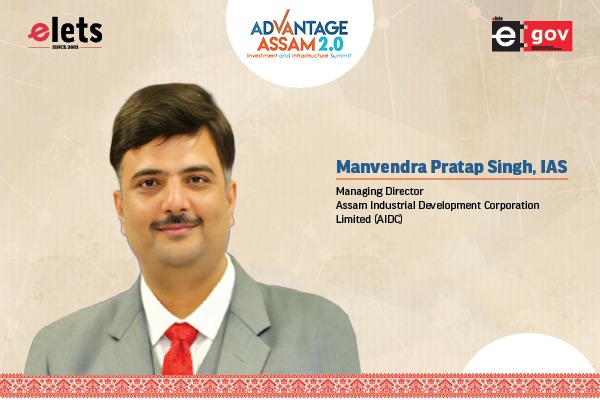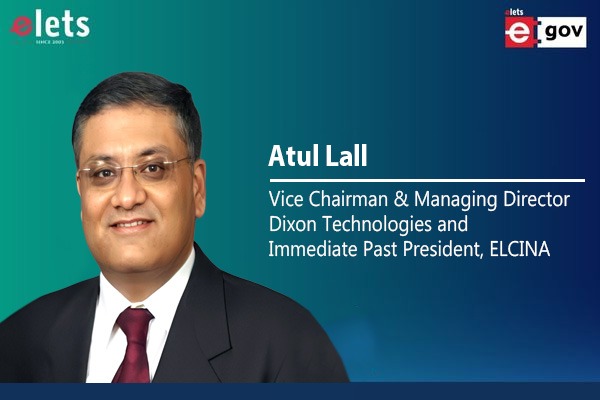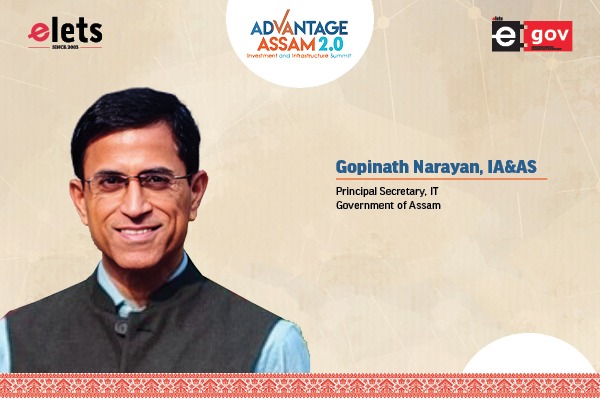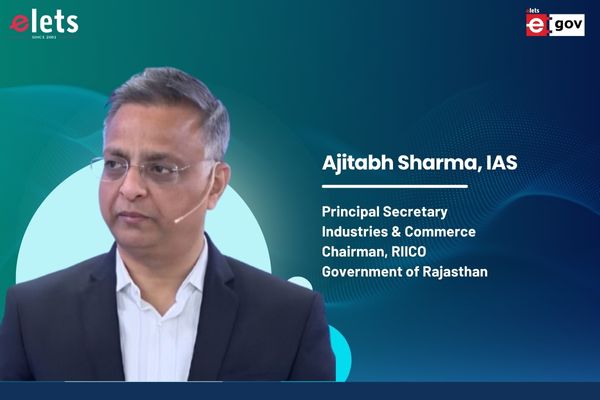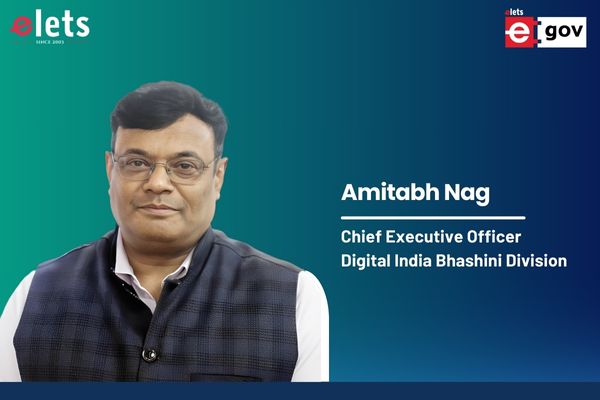
From handling traffic congestion to waste management, addressing environmental concerns and citizens’ grievances, Rajkot is making full use of emerging technologies to make the city smart and livable, shares Anand Patel, IAS, Municipal Commissioner, Rajkot Municipal Corporation in an exclusive interaction with Abhineet Kumar & Shalini Rawat of Elets News Network (ENN). Edited excerpts:
As the Municipal Commissioner, what is your vision for the development and growth of Rajkot?
Rajkot has a rich history and a promising future. My vision for Rajkot revolves around sustainable development, community engagement, and creating a city that thrives on innovation.

First and foremost, I’d focus on infrastructure. Upgrading and modernizing transportation systems, ensuring efficient waste management, and promoting ecofriendly initiatives would be top priorities. A city that moves smoothly and cares for its environment is a city on the right track.
Next, I’d emphasize education and skill development. Investing in schools, colleges, and vocational training centers will empower the youth and contribute to a knowledgeable and skilled workforce. A city’s progress is intricately tied to the education and capabilities of its residents.

Community participation is vital. I’d encourage citizen involvement in decision-making processes through town hall meetings, surveys, and other platforms. This inclusivity ensures that the development aligns with the needs and aspirations of the people.
Economic growth is key, and I’d strive to attract businesses that align with Rajkot’s strengths and values. This could range from supporting local industries to fostering a culture of entrepreneurship and innovation.
Rajkot Municipal Corporation (RMC) is dedicated to enhancing the city’s green cover by planting 7 to 8 lakh trees in the areas surrounding Aji and Nyari dam, as well as the Nakarawadi dumping site. This initiative reflects RMC’s commitment to environmental sustainability and fostering a greener and healthier urban environment. By strategically focusing on these locations, the corporation aims to contribute significantly to the overall greenery and ecological balance in the city.
Lastly, I’d promote cultural and recreational activities. Parks, museums, and events that celebrate the city’s heritage and diversity create a vibrant and connected community. After all, a city isn’t just buildings and roads; it’s the heartbeat of its people.
How do you plan to address the city’s infrastructure challenges, such as traffic congestion and waste management, to ensure sustainable urban development?
To tackle traffic congestion, we would like to initiate a comprehensive traffic management plan. This would involve expanding and improving road networks, augmenting multilayer parking, extending smart traffic signaling systems to higher number of junctions, and promoting alternative modes of transportation like cycling and enhancing public transit. We might also explore the possibility of creating pedestrian-friendly zones to enhance safety and encourage a more active lifestyle.
Waste management is a critical issue, and my approach would include a multipronged strategy. We would like to invest in advanced waste separation and recycling facilities, promote waste-toenergy initiatives, and launch public awareness campaigns on reducing, reusing, and recycling. Community involvement would be key—encouraging residents to actively participate in waste management practices.
Additionally, I’d explore smart technologies for monitoring and managing both traffic and waste. Implementing intelligent systems can lead to more efficient resource utilization and better decisionmaking.
Of course, sustainable urban development requires a long-term vision. I’d work on creating and enforcing policies that prioritize environmental sustainability, ensuring that the city’s growth doesn’t come at the cost of its natural resources.
Are there any innovative approaches or technologies you are considering to improve the city’s infrastructure?
As part of the smart city initiative, Rajkot was one of the pioneers to implement surveillance projects and ensure safety and security of citizens. Now, since the video feed alone is not doing the job for the urban local body, RMC is moving ahead in adopting the need of the hour – video analytics solution to address chronic issues pertaining to the encroachment, wrong parking, littering, spitting and animal detection on roads. This shall help achieve smooth traffic flow along with the cleanliness on roads.
Quality of Road was and is the prime focus of RMC and to further strengthen our focus, Artificial Intelligence (AI) driven road assessment shall be undertaken to capture anomalies on road, resurface related issues etc. This shall provide a 360 degree outlook to the city authorities and also ensure quality roads for the citizens.
Encroachment removal in densed market areas has always been a challenge for many of the ULBs and to mitigate the gap between hawkers and city authorities, RMC shall implement body worn cameras based surveillance and video recording of routine enforcement activity. This shall strengthen the enforcement process end to end and citizens shall get benefit in peak hours.
In waste management, we would look into deploying sensor-based smart bins that notify collection services when they’re full. This not only improves efficiency but also reduces the chances of overflowing bins. Additionally, investing in waste-toenergy technologies, such as anaerobic digestion or thermal treatment, can help turn waste into a valuable resource.
Further, smart city platforms that integrate various services and data sources can be instrumental in effective governance. These platforms can enable better decision-making by providing real-time insights into various aspects of city management, from traffic patterns to energy consumption to grievance management to property tax collection.
These are just a few innovative ideas, and the key is to continually explore and adopt technologies that align with the city’s goals and contribute to a more sustainable and livable environment.
Can you highlight any successful community-driven initiatives that have been implemented under your leadership?
The active involvement of social groups and citizens in cleanliness drives and waste management initiatives is a testament to the community’s commitment to building a better and more sustainable city. It’s heartening to see the synergy between the local government and its residents in creating a cleaner and more environmentally conscious Rajkot.
Also Read | Synchronised Approach to Emission Reduction in Waste Management
The emphasis on citizen education programs is particularly noteworthy. When people are informed and engaged, it not only enhances the effectiveness of waste management but also fosters a sense of shared responsibility. It’s a beautiful example of how a community can come together to address common challenges.
Waste segregation at the source is a key step towards efficient waste management, and it’s wonderful that Rajkot citizens are actively participating in this process. This not only streamlines the waste disposal system but also contributes to the larger goal of sustainable living.
These initiatives underscore the importance of collaboration between the local government and its residents. By empowering communities and tapping into their unique strengths, we can create a city that is not only wellmanaged but also a great place to live.
Rajkot is part of the Smart Cities Mission. What key smart city initiatives have been implemented or are in the pipeline to enhance the city’s efficiency and livability?
Rajkot’s engagement with the Smart Cities Mission stands as a testament to its forward-thinking approach to urban development. Leveraging the opportunity presented by the mission, the city has embarked on a non-conventional project, focusing on a greenfield area-based development (ABD) as part of its smart city initiative.
This ambitious project spans over 930 acres, and its centerpiece is a robust underground infrastructure. This includes smart roads, potable water networks, recycled water networks, sewer networks, stormwater drains, ICT and power ducts, smart street lights, and a clear and recycled water reservoir for the Bus Rapid Transit System (BRTS). Additionally, the development incorporates 50 acres of green and landscape areas, with a significant 23-acre public water body nearing completion. The surrounding area is envisioned to host multiple activity centers, designed to capture the attention and engagement of the city’s residents.
Rajkot’s pioneering efforts extend beyond physical infrastructure. The city was an early adopter of a city-wide surveillance network, resulting in an 18% reduction in crime rates. The implementation of the Integrated Command and Control Center (ICCC), featuring a traffic enforcement system, has played a crucial role in instilling traffic discipline at key junctions.
In the second phase of development, Rajkot has honed its focus on smart traffic signals, an enhanced transportation management system, and city-wide optical fiber communication to provide seamless connectivity to all offices of the Rajkot Municipal Corporation (RMC). The city has also undertaken an underground utilities survey covering the entire city, along with geo-tagging all properties. The culmination of these efforts is the creation of a Geographical Information System (GIS) portal, boasting over 100 layers of information related to the city’s assets. The RMC has made this portal public, facilitating information dissemination to the citizens.
The integration of technology extends to governance through the establishment of a smart city platform. This centralized hub provides real-time data on various urban aspects, ranging from energy consumption to air quality and traffic insights. It empowers decision-makers and citizens alike with valuable insights for better planning, resource allocation, and emergency management. During the COVID-19 pandemic, Rajkot swiftly repurposed its ICCC into a COVID war room, ensuring efficient public service delivery.
RMC has cleverly introduced its services on WhatsApp, streamlining access to online services for its citizens. The use of a familiar platform like WhatsApp ensures convenience for people of all age groups. By simply sending a ‘Hi’ message to the designated number (+91-9512301973), citizens can access a range of RMC services (172+ services), making it a user-friendly experience. This initiative not only saves time for citizens but also provides them with language options for more personalized communication in English or Gujarati. RMC has successfully implemented an advanced Citizen Grievance Redressal System to efficiently handle and resolve citizen concerns, leading to a substantial boost in trust and satisfaction. The system’s standout features include multiple user-friendly options for complaint registration, automated escalation processes,requirement of a PIN for closure of critical complaints and feedback mechanism. Well-defined service level agreements at each official level ensure timely resolution, accompanied by a feedback mechanism and the option for citizens to reopen dissatisfactory complaints, promoting transparency and citizen involvement. This initiative of RMC is the recipient of the very prestigious National E-Governance Award, 2022.
As these initiatives mark just the beginning, Rajkot is poised to continue its journey of technological adoption. The city envisions adopting more projects driven by artificial intelligence (AI) to address real-life challenges in real-time, solidifying its commitment to becoming a smarter, more efficient, and livable city.
Given the increasing concern for environmental sustainability, what steps are being taken to make Rajkot more eco-friendly and resilient to climate change?
Addressing environmental sustainability and building resilience to climate change is a top priority. In Rajkot, we’ve initiated a range of measures to promote ecofriendliness and climate resilience.
The city is investing in green spaces, tree planting initiatives, and the creation of urban parks. These not only enhance the aesthetic appeal of the city but also contribute to improved air quality and overall well-being.
To reduce the carbon footprint, we’re actively promoting the use of renewable energy sources.RMC leading from the front has implemented a 4 MW solar plant in an open space to promote green and renewable energy.
RMC has implemented water recharge in various areas of the city, planning to have oxygen park in each ward of the city, ensure green building norms for each new building plan approval, conversion of traditional diesel buses to E Bus, incentivize the E auto adoption by giving INR 30,000 subsidy to auto owners and INR 1,000 subsidy on purchase of eco friendly bicycles etc. RMC plans on replacing all the diesel City Buses with CNG & Electric Buses in the coming year.
Infrastructure projects are being designed with climate resilience in mind. This includes ensuring that roads, buildings, and other structures can withstand extreme weather events and adapting urban planning to mitigate the impact of climate change.
Also Read | Behavioural Change: An Efficient Strategy for Waste Management
RMC’s adoption of Miyawaki plantation cover drives involves planting a variety of native trees in a compact space, creating a dense and thriving forest ecosystem. This initiative not only contributes to increasing green cover but also promotes biodiversity, improves air quality, and enhances the overall ecological balance in the city.
RMC’s implementation of dual plumbing systems in the greenfield area is a forward-thinking approach to water conservation. This system separates potable water from recycled or nonpotable water, providing an alternative water source for non-drinking purposes like irrigation and flushing.By reducing the demand for fresh water in nonessential applications, this initiative helps conserve precious water resources and promotes sustainable water management practices.
Atal Sarovar, a water conservation project, is a testament to RMC’s dedication to preserving water resources. This initiative likely involves the construction of reservoirs or ponds to capture and store rainwater, preventing runoff and replenishing groundwater.Water conservation projects like Atal Sarovar contribute to mitigating water scarcity issues, especially in regions prone to seasonal variations in rainfall.
Moreover, awareness campaigns on sustainable practices, waste reduction, and the importance of environmental conservation are regularly conducted to foster a culture of environmental responsibility among residents.
These environmental initiatives collectively reflect RMC’s holistic approach to addressing ecological challenges. By embracing innovative afforestation methods, implementing sustainable water management practices, and conserving water resources, RMC is actively contributing to a greener and more environmentally resilient Rajkot.
Be a part of Elets Collaborative Initiatives. Join Us for Upcoming Events and explore business opportunities. Like us on Facebook , connect with us on LinkedIn and follow us on Twitter, Instagram.
"Exciting news! Elets technomedia is now on WhatsApp Channels Subscribe today by clicking the link and stay updated with the latest insights!" Click here!




